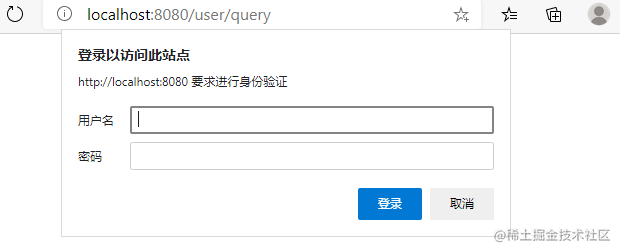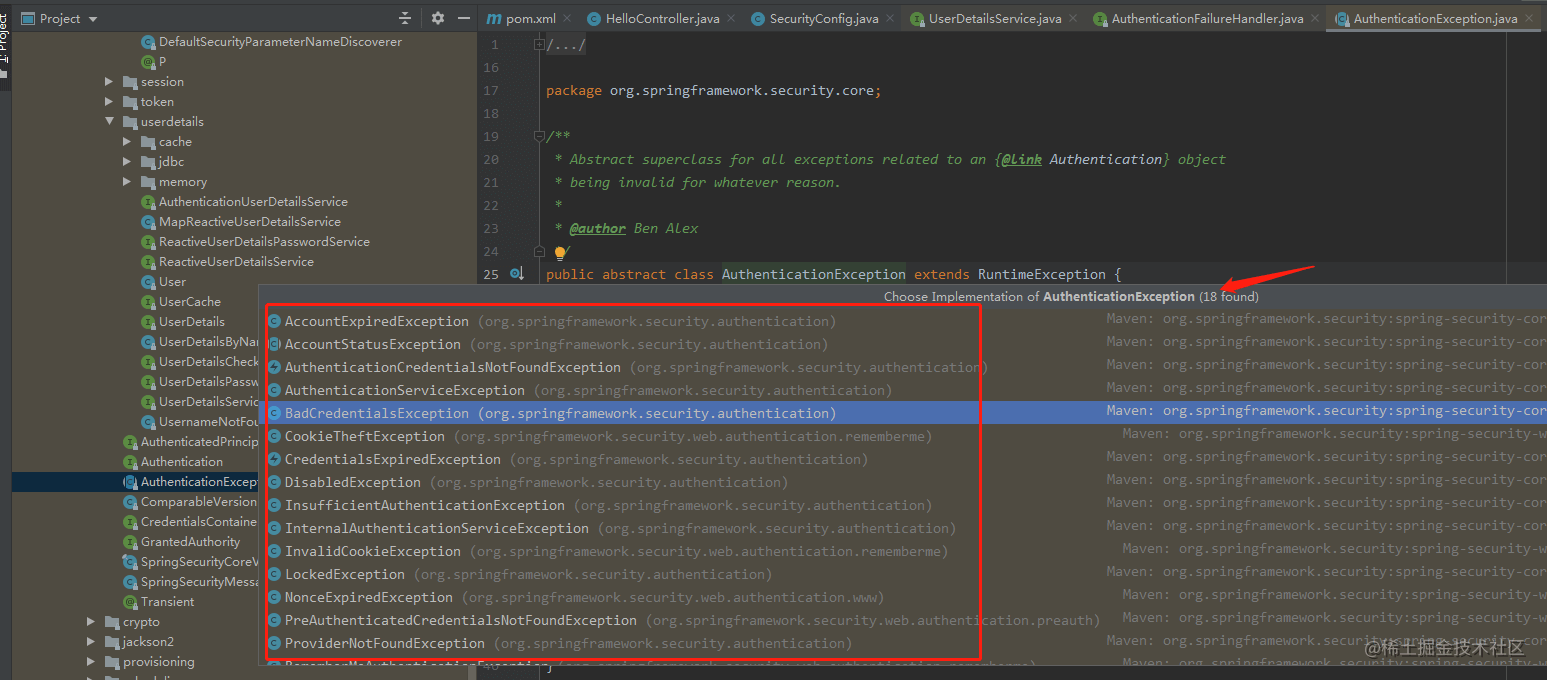给网友们整理相关的编程文章,网友班嘉福根据主题投稿了本篇教程内容,涉及到SpringSecurity自定义Form表单、SpringSecurity Form表单、SpringSecurity Form表单相关内容,已被592网友关注,涉猎到的知识点内容可以在下方电子书获得。
SpringSecurity Form表单
背景
本系列教程,是作为团队内部的培训资料准备的。主要以实验的方式来体验SpringSecurity的各项Feature。
新建一个SpringBoot项目,起名springboot-security-form,核心依赖为Web,SpringSecurity与Thymeleaf。
<dependencies><dependency><groupId>org.springframework.boot</groupId><artifactId>spring-boot-starter-web</artifactId></dependency><dependency><groupId>org.springframework.boot</groupId><artifactId>spring-boot-starter-thymeleaf</artifactId></dependency><dependency><groupId>org.springframework.boot</groupId><artifactId>spring-boot-starter-security</artifactId></dependency><dependency><groupId>org.springframework.boot</groupId><artifactId>spring-boot-devtools</artifactId><scope>runtime</scope><optional>true</optional></dependency><dependency><groupId>org.projectlombok</groupId><artifactId>lombok</artifactId><optional>true</optional></dependency><dependency><groupId>org.springframework.boot</groupId><artifactId>spring-boot-starter-test</artifactId><scope>test</scope></dependency> </dependencies>
实验-HttpBasic
@Override
protected void configure(AuthenticationManagerBuilder auth) throws Exception {// There is no PasswordEncoder mapped for the id "null"PasswordEncoder encoder = PasswordEncoderFactories.createDelegatingPasswordEncoder();String yourPassword = "123";System.out.println("Encoded password: " + encoder.encode(yourPassword));// Config account info and permissionsauth.inMemoryAuthentication().withUser("dev").password(encoder.encode(yourPassword)).authorities("p1").and().withUser("test").password(encoder.encode(yourPassword)).authorities("p2");
}
@Override
protected void configure(HttpSecurity http) throws Exception {http.authorizeRequests().antMatchers("/user/add").hasAuthority("p1").antMatchers("/user/query").hasAuthority("p2").antMatchers("/user/**").authenticated().anyRequest().permitAll() // Let other request pass.and().httpBasic();
}

实验-自定义登录页面
登录页面配置
@Override
protected void configure(HttpSecurity http) throws Exception {http.authorizeRequests().antMatchers("/user/add").hasAuthority("p1").antMatchers("/user/query").hasAuthority("p2").antMatchers("/user/**").authenticated().anyRequest().permitAll() // Let other request pass.and().csrf().disable() // turn off csrf, or will be 403 forbidden.formLogin() // Support form and HTTPBasic.loginPage("/login");
}
后端登录页面接口
@Controller
public class LoginController {@GetMapping("/login")public String login() {return "login";}@GetMapping(value = "/user/add")@ResponseBodypublic String accessResource1() {return " Access Resource 1: Add User";}@GetMapping(value = "/user/query")@ResponseBodypublic String accessResource2() {return " Access Resource 2: Query User";}
}
前端模板
<!DOCTYPE html> <html lang="en"> <head><meta charset="UTF-8"><title>Login</title> </head> <body> <form action="login" method="post"><span>用户名</span><input type="text" name="username" /> <br><span>密码</span><input type="password" name="password" /> <br><input type="submit" value="登录"> </form> </body> </html>
Note:此时,需要先关闭CSRF,.csrf().disable(),否则报403;
实验-自定义登录接口
默认登录页面接口与登录数据提交接口是同一个:/login,顺着.loginPage,进入FormLoginConfigurer,源码如下:
@Override
public FormLoginConfigurer<H> loginPage(String loginPage) {return super.loginPage(loginPage);
}
继续进入父类的loginPage方法,
protected T loginPage(String loginPage) {setLoginPage(loginPage);updateAuthenticationDefaults();this.customLoginPage = true;return getSelf();
}
继续跟踪进入方法updateAuthenticationDefaults();,可以看到,如果没有配置loginProcessingUrl,那么loginProcessingUrl与loginPage便相同。
protected final void updateAuthenticationDefaults() {if (loginProcessingUrl == null) {loginProcessingUrl(loginPage);}if (failureHandler == null) {failureUrl(loginPage + "?error");}final LogoutConfigurer<B> logoutConfigurer = getBuilder().getConfigurer(LogoutConfigurer.class);if (logoutConfigurer != null && !logoutConfigurer.isCustomLogoutSuccess()) {logoutConfigurer.logoutSuccessUrl(loginPage + "?logout");}
}
下面我们自定义登录数据提交接口为/formLogin,此时相应的前端action也要修改。
@Override
protected void configure(HttpSecurity http) throws Exception {http.authorizeRequests().antMatchers("/user/add").hasAuthority("p1").antMatchers("/user/query").hasAuthority("p2").antMatchers("/user/**").authenticated().anyRequest().permitAll() // Let other request pass.and().csrf().disable() // turn off csrf, or will be 403 forbidden.formLogin() // Support form and HTTPBasic.loginPage("/login").loginProcessingUrl("/formLogin");
}
<form action="formLogin" method="post"><span>用户名</span><input type="text" name="username" /> <br><span>密码</span><input type="password" name="password" /> <br><input type="submit" value="登录"> </form>
实验-自定义登录数据参数
前面我们自定义了登录页面,在form表单中设置用户名、密码分别为username, password,那为什么这样写呢,可以改成别的嘛?可以倒是可以,但是不能随便改;
如果这里我们把username改为name,再次尝试登录,后端接口将报错:org.springframework.security.authentication.BadCredentialsException: Bad credentials。。可是实际项目中我们的用户名密码就是不叫这个名字呢?我们可以进行配置.usernameParameter("name"):
@Override
protected void configure(HttpSecurity http) throws Exception {http.authorizeRequests().antMatchers("/user/add").hasAuthority("p1").antMatchers("/user/query").hasAuthority("p2").antMatchers("/user/**").authenticated().anyRequest().permitAll() // Let other request pass.and().csrf().disable() // turn off csrf, or will be 403 forbidden.formLogin() // Support form and HTTPBasic.loginPage("/login").loginProcessingUrl("/formLogin").usernameParameter("name");
}
<form action="formLogin" method="post"><span>用户名</span><input type="text" name="name" /> <br><span>密码</span><input type="password" name="password" /> <br><input type="submit" value="登录"> </form>
默认的用户名、密码分别为username, password,我们看下SpringSecurity的源码:
public final class FormLoginConfigurer<H extends HttpSecurityBuilder<H>> extends
AbstractAuthenticationFilterConfigurer<H, FormLoginConfigurer<H>, UsernamePasswordAuthenticationFilter> {
/**
* Creates a new instance
* @see HttpSecurity#formLogin()
*/
public FormLoginConfigurer() {
super(new UsernamePasswordAuthenticationFilter(), null);
usernameParameter("username");
passwordParameter("password");
}
}
实验-自定义登录失败、成功处理器
问题:就以上个实验3中的报错信息为例,或当用户名、密码输错后,如何在后台看到错误信息?
@Override
protected void configure(HttpSecurity http) throws Exception {http.authorizeRequests().antMatchers("/user/add").hasAuthority("p1").antMatchers("/user/query").hasAuthority("p2").antMatchers("/user/**").authenticated().anyRequest().permitAll() // Let other request pass.and().csrf().disable() // turn off csrf, or will be 403 forbidden.formLogin() // Support form and HTTPBasic.loginPage("/login").loginProcessingUrl("/formLogin").usernameParameter("name").failureHandler(new AuthenticationFailureHandler(){@Overridepublic void onAuthenticationFailure(HttpServletRequest request, HttpServletResponse response, AuthenticationException exception) throws IOException, ServletException {exception.printStackTrace();request.getRequestDispatcher(request.getRequestURL().toString()).forward(request, response);}});
}
常见的认证异常,这里可以看到AuthenticationException共有18个子类:

上述增加了在认证失败时的处理:输出错误信息。同理,如果想在登录成功时直接进行一些处理(eg: 数据初始化等),可以使用以下配置:
.successHandler(new AuthenticationSuccessHandler() {@Overridepublic void onAuthenticationSuccess(HttpServletRequest request, HttpServletResponse response,Authentication authentication) throws IOException, ServletException {System.out.println("Login Successfully~");// do something here: initial work or forward to different url regarding different roles...request.getRequestDispatcher("").forward(request, response);}
})
实验-自定义登录成功跳转页面
经历千难万险,终于要登录成功了。进来之后要跳转到哪里呢?看你喽~想跳哪里跳哪里。。
@Override
protected void configure(HttpSecurity http) throws Exception {http.authorizeRequests().antMatchers("/user/add").hasAuthority("p1").antMatchers("/user/query").hasAuthority("p2").antMatchers("/user/**").authenticated().anyRequest().permitAll() // Let other request pass.and().csrf().disable() // turn off csrf, or will be 403 forbidden.formLogin() // Support form and HTTPBasic.loginPage("/login").loginProcessingUrl("/formLogin").usernameParameter("name").failureHandler(new AuthenticationFailureHandler(){@Overridepublic void onAuthenticationFailure(HttpServletRequest request, HttpServletResponse response, AuthenticationException exception) throws IOException, ServletException {exception.printStackTrace();request.getRequestDispatcher(request.getRequestURL().toString()).forward(request, response);}}).successForwardUrl("/ok"); // custom login success page, a POST request
}
@Controller
public class LoginController {...@PostMapping(value = "/ok")@ResponseBodypublic String ok() {return "ok";}
}
通过.successForwardUrl("/ok")配置了登录成功之后要跳转的页面路径或接口,同时需要在后端新增/ok接口。
Note:
- 注意这里
successForwardUrl的接口必须为POST接口; - 除了
.successForwardUrl("/ok");,还可以使用.defaultSuccessUrl("/ok");或者.defaultSuccessUrl("/ok", true);第二个参数true表示不管是从哪个地址进来,登录后全部跳转到指定的地址,此时与successForwardUrl效果相同,默认为false - 当然,除了登录成功后的跳转,还有登录失败后的跳转:
failureForwardUrl。
实验-自定义退出接口
默认的退出接口是/logout,可进行配置:
@Override
protected void configure(HttpSecurity http) throws Exception {http.authorizeRequests().antMatchers("/user/add").hasAuthority("p1").antMatchers("/user/query").hasAuthority("p2").antMatchers("/user/**").authenticated().anyRequest().permitAll() // Let other request pass.and().csrf().disable() // turn off csrf, or will be 403 forbidden.formLogin() // Support form and HTTPBasic.loginPage("/login").loginProcessingUrl("/formLogin").usernameParameter("name").failureHandler(new AuthenticationFailureHandler(){@Overridepublic void onAuthenticationFailure(HttpServletRequest request, HttpServletResponse response, AuthenticationException exception) throws IOException, ServletException {exception.printStackTrace();request.getRequestDispatcher(request.getRequestURL().toString()).forward(request, response);}}).successForwardUrl("/ok") // custom login success page, a POST request.and().logout().logoutUrl("/leave");}
上述配置将退出接口改为/leave。在默认的退出过程中,还做了诸如清除认证信息和使Session失效等工作:
public class SecurityContextLogoutHandler implements LogoutHandler {
protected final Log logger = LogFactory.getLog(this.getClass());
private boolean invalidateHttpSession = true;
private boolean clearAuthentication = true;
// ~ Methods
// ==========================================
/**
* Requires the request to be passed in.
*
* @param request from which to obtain a HTTP session (cannot be null)
* @param response not used (can be <code>null</code>)
* @param authentication not used (can be <code>null</code>)
*/
public void logout(HttpServletRequest request, HttpServletResponse response,
Authentication authentication) {
Assert.notNull(request, "HttpServletRequest required");
if (invalidateHttpSession) {
HttpSession session = request.getSession(false);
if (session != null) {
logger.debug("Invalidating session: " + session.getId());
session.invalidate();
}
}
if (clearAuthentication) {
SecurityContext context = SecurityContextHolder.getContext();
context.setAuthentication(null);
}
SecurityContextHolder.clearContext();
}
} 到此这篇关于SpringSecurity自定义Form表单使用方法讲解的文章就介绍到这了,更多相关SpringSecurity Form表单内容请搜索码农之家以前的文章或继续浏览下面的相关文章希望大家以后多多支持码农之家!









